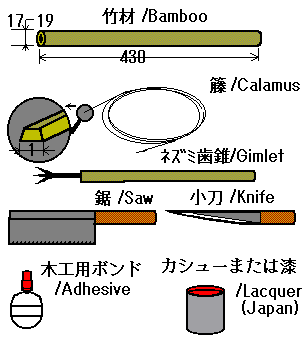 There are several kinds of traditional transverse flutes in Japan,
There are several kinds of traditional transverse flutes in Japan, Shinobue, Ryuteki, Komabue, Kagurabue, Nohkan, and many kinds of local flutes.
These flutes were inherited for a long time through a lot of generations.



 There are several kinds of traditional transverse flutes in Japan,
There are several kinds of traditional transverse flutes in Japan,
Shinobue, Ryuteki, Komabue, Kagurabue, Nohkan, and many kinds of local flutes.
These flutes were inherited for a long time through a lot of generations.










This scale is a reference of '7-hon' Shinobue flute for 'Uta'.
Paint inside the pipe with cinnabar "Japan".
The porpose of winding the calamus is to prevent splitting and for decoration.
Almost all Japanese can sing a song 'Sakura'.
Read this vertical score from right side to left side.
Click this score to play the first phrase of Sakura
Each bamboo material is different, respectivery.
Therefore this scale is only one sample.
The musical scale 0 :





Make one embouchure and seven finger holes.
First, bore the basic holes at the center of the mark with gimlet.
Next, shave the ellipse holes at a right angle.
Don't go against the direction of the bamboo's fiber.
Be careful not to be too strong. Do it gently.




The porpose of painting is to prevent splitting and to get a clear sound.
Substitute for 'Japan' : 'Kasyu' paint or industrial cinnabar. Paint 2 or 3 times.
Several days later, it will dry, and you can blow with upper cork-stopper.




Shave about 0.5mm depth the bark of bamboo ,and wind calamus with glue.





Put your right hand on the flute and cover four holes with center(not top) of your right fingers, in right angle to the flute.
Put your left fingers on three holes on an angle to flute.
This numeral description of Shinobue score was worked out half-century before
The score consists of Japanese and European numerals. These numbers indicate the musical scale. Japanese numeral shows lower tone "Fukura", and Europeans shows higher tone "Seme".
The other clefs show length of tone.



Let's play flute slowly.
"Sa-ku-ra, Sa-ku-ra, Ya-yo-i-no-so-ra-a-wa, Mi-wa-ta-su-ka-gi-i-ri..."
 to Top
to Top
 For more information to Japanese Flute Homepage (Asahi-net)
For more information to Japanese Flute Homepage (Asahi-net)